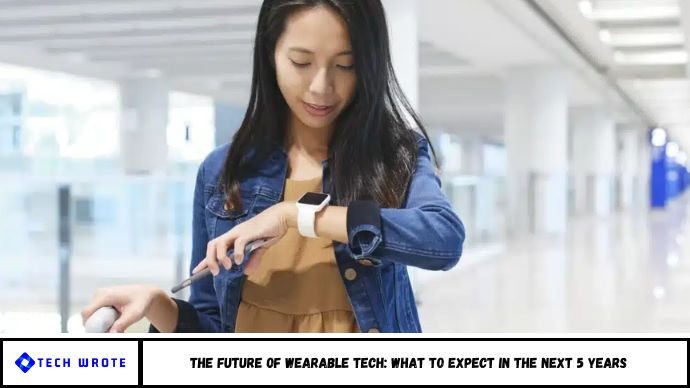The future of wearable technology is poised to transform everyday life, blending real-time health insights, AI integration, and smarter design. This article explores what to expect from the next five years of wearable innovation—spanning healthcare, augmented reality, data privacy, and connected ecosystems.
Introduction: Are Wearables Just Getting Started?
What if your watch could predict a heart condition before symptoms appear, or your glasses could replace your smartphone? This isn’t science fiction—it’s the direction wearable tech is heading.
In the past decade, wearables like fitness trackers and smartwatches became mainstream. But these devices are evolving beyond step counters and heart rate monitors. Over the next five years, expect significant advances in how wearables improve health, productivity, and everyday convenience.
Current Limitations: Why Wearables Still Feel Incomplete
Before looking forward, it’s important to understand the challenges holding current wearables back:
- Battery constraints limit continuous usage
- Inconsistent sensor accuracy affects data reliability
- Privacy and security risks concern many users
- Limited functionality makes many devices one-dimensional
These issues are being addressed as technology and regulation evolve, opening the door to more robust and user-friendly solutions.
1. Medical-Grade Monitoring Will Go Mainstream
One of the most significant developments in wearable tech is its increasing medical credibility. The next generation of devices will do far more than track steps or sleep.
What to expect:
- Non-invasive continuous glucose monitoring
- Smartwatches capable of detecting atrial fibrillation and blood pressure changes
- FDA-cleared wearables with diagnostic-level accuracy
Industry insight: Deloitte projects that over 320 million health-focused wearables will be in use globally by 2026, up from 256 million in 2023. These tools will play a growing role in preventive care and remote health monitoring.
2. Smarter Wearables Powered by AI
Artificial intelligence is becoming integral to wearable functionality. Instead of simply collecting data, future wearables will interpret it and take action.
Key AI-driven capabilities:
- Personalized health coaching based on biometrics
- Predictive analytics for stress, recovery, and performance
- Smart responses to environmental and behavioral changes
AI will allow wearables to provide context-aware feedback, turning raw data into actionable insights.
3. The Rise of AR and Smart Glasses
Wearables are moving beyond the wrist. Smart glasses equipped with augmented reality (AR) capabilities are on track to become a dominant category.
Expected innovations:
- Heads-up displays for navigation, work, and real-time collaboration
- Voice-activated assistants and built-in cameras
- Lightweight, fashionable designs suitable for daily wear
Analysts predict AR wearables will start replacing smartphone use in areas like notifications, directions, and media consumption by 2028.
4. Biometric Security and Data Protection
As wearables become more advanced, they gather more sensitive data. Users are demanding better privacy and more control.
Security enhancements to watch:
- Biometric logins based on heartbeat patterns or gait
- On-device AI processing to reduce cloud data exposure
- Transparent privacy policies and stronger encryption standards
Statista reports that 63 percent of wearable users have concerns about data privacy. Addressing these concerns is crucial for broader adoption.
5. Fashion Meets Functionality
Next-gen wearables won’t just be smart—they’ll look and feel better, too. Companies are working to integrate technology seamlessly into everyday apparel.
Trends to expect:
- Collaborations between luxury brands and tech firms
- Smart fabrics that monitor health without bulky devices
- Modular and customizable designs to fit personal style
Wearables will shift from being gadgets to being part of your identity.
6. Integration Across Devices and Platforms
The future of wearables involves tighter integration across digital ecosystems, enhancing how users interact with their environment.
Examples include:
- Controlling smart homes from a watch or ring
- Linking wearable data to cars, phones, and medical records
- Workplace productivity tools for remote support and logistics
With the rise of 5G and edge computing, these integrations will happen in real time with minimal lag.
FAQs
1. Will wearables replace smartphones?
Not completely, but wearables will handle many core tasks such as calls, messages, and navigation.
2. How accurate will future health wearables be?
Many will meet medical-grade standards, with approval from regulatory bodies like the FDA.
3. Are smart glasses going mainstream?
Yes. Major tech companies are preparing to release consumer-ready smart glasses by 2026.
4. Is wearable tech safe for long-term use?
Yes. With advancements in biometric security and data control, wearables are increasingly safe for continuous use.
5. Can wearables detect early health issues?
Yes. AI-enabled sensors will help detect signs of conditions before symptoms appear.
6. What’s the main benefit of next-gen wearables?
They offer real-time insights and seamless connectivity that enhance daily life and long-term health.
Conclusion
Wearable technology is on the verge of a major evolution. In the next five years, we’ll see devices that not only monitor health but predict it, that not only connect us but enhance how we live and work.
Whether you’re a consumer interested in better health tracking, a business exploring workforce integration, or a tech enthusiast following innovation trends, the future of wearables offers something meaningful. The key is staying informed—and ready to adapt.


